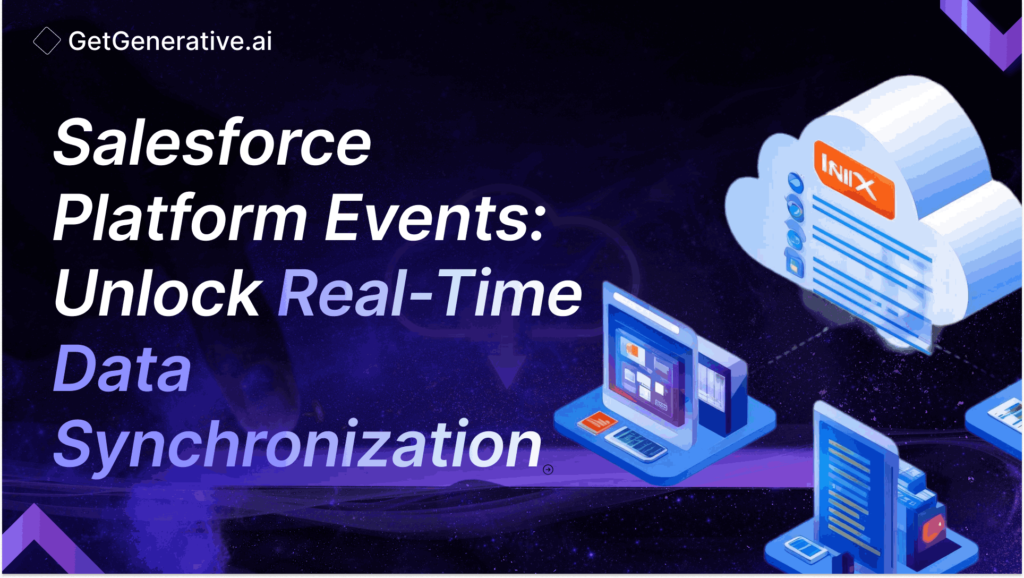Salesforce Platform Events: Unlock Real-Time Data Synchronization
According to recent statistics, over 70% of enterprises have adopted cloud-based CRM systems, with Salesforce leading the market share at 19.8% in 2023.
Platform Events enable organizations to efficiently handle integration scenarios and real-time communication between Salesforce and external systems.
Overview of Platform Events
Platform Events in Salesforce are a scalable and flexible way to deliver secure and customizable event notifications within Salesforce or to external systems. They follow a publish-subscribe model, in which publishers send event messages to subscribers in real time. This architecture ensures that different systems can communicate and react to events as they happen.
Key Components
- Event Definition: Defines the event schema, including custom fields with event data.
- Event Publishing: Creating and sending event messages within Salesforce or external systems.
- Event Subscribers: Systems or applications that listen for and process the published events.
Implementation
Implementing Platform Events in Salesforce involves several key steps and considerations to ensure seamless integration and effective real-time communication. Here’s a detailed guide on how to implement Platform Events:
Define Platform Event
- Create a Platform Event Object: Start by creating a new Platform Event object in Salesforce. Navigate to Setup -> Platform Events -> New Platform Event. Define the event name and add custom fields to hold the event data.
- Schema Definition: The schema for the Platform Event should include only the necessary fields to keep the event payload lightweight. Common fields might include IDs, timestamps, status updates, and other relevant data points.
Publish Events
- Using Apex Code: You can publish Platform Events using Apex by creating an instance of the event and using the EventBus.publish() method.
MyEvent__e event = new MyEvent__e(
Field1__c = ‘Value1’,
Field2__c = ‘Value2’);
EventBus.publish(event);
- Using Process Builder: Process Builder lets you publish events without writing code. Create a new process, define the criteria, and add an action to publish the event.
- Using Flow: Like Process Builder, Salesforce Flow can publish Platform Events. Create a flow that triggers a specific condition and includes the action to publish the event.
- Using API Calls: External systems can publish Platform Events using the Salesforce REST API. Authenticate the external system and make a POST request to the appropriate endpoint with the event data.
Subscribe to Events
- Apex Triggers: Create an Apex Trigger on the Platform Event to process incoming events.
trigger MyEventTrigger on MyEvent__e (after insert) {
for (MyEvent__e event : Trigger.New) {
// Process event }}
- CometD and Streaming API: External systems can subscribe to Platform Events using the CometD protocol and the Salesforce Streaming API. Set up a CometD client to listen to and handle events as they arrive.
- Platform Event Triggers in Flows: Use Salesforce Flow to create a Platform Event-triggered flow that runs when an event message is received.
Monitoring and Debugging
- Event Logs: Use the Event Log Files to monitor event publishing and delivery. Navigate to Setup -> Platform Events -> Event Log Files.
- Debug Logs: Enable debug logs for users or processes involved in publishing or subscribing to Platform Events to troubleshoot issues.
- Event Replay ID: Use the EventBus API to replay events from a specific time, which is useful for debugging and ensuring no events are missed during downtime.
Error Handling
- Retry Mechanisms: Implement retry mechanisms for event processing failures. Apex Triggers and external systems should be designed to handle transient errors gracefully.
- Dead Letter Queue: Utilize the Dead Letter Queue (DLQ) for undeliverable events. Events that fail to be processed can be rerouted to the DLQ for further analysis and reprocessing.
Performance Considerations
Bulk Processing: Ensure that event processing logic can handle bulk operations efficiently. Use batch processing techniques to manage large volumes of events.
Governor Limits: Be aware of Salesforce governor limits related to Platform Events, such as limits on event publishing, subscription, and storage. Design your implementation to stay within these limits.
Limitations
While Platform Events are powerful, they come with certain limitations:
- Event Retention: Events are stored temporarily and are not intended for long-term storage.
- Governor Limits: The number of events that can be published and subscribed to within 24 hours is limited.
How Do Platform Events Improve Integration with External Systems?
Platform Events facilitate smooth integration by allowing real-time communication between Salesforce and external systems. They support event-driven architecture, enabling external systems to subscribe to Salesforce events and act upon them immediately. This reduces latency and enhances the responsiveness of integrated systems.
Best Practices for Setting Up Platform Events in Salesforce
- Define Clear Use Cases: Ensure that the use cases for Platform Events are well-defined and justified.
- Optimize Event Payload: Keep event messages lightweight to minimize processing time.
- Monitor and Debug: Use Salesforce’s monitoring tools to track event delivery and troubleshoot issues.
- Respect Limits: Be mindful of Salesforce’s governor limits and design your solution accordingly.
Also Read – Relationships in Salesforce: A Complete Guide
Can Platform Events Be Used for Real-Time Data Synchronization?
Yes, Platform Events are ideal for real-time data synchronization. They enable instant data updates across systems, ensuring all connected applications have the latest information without significant delays.
How Do Platform Events Differ from Standard Salesforce Events?
Standard Salesforce events, such as workflow rules and process builders, are primarily used for internal automation within Salesforce. In contrast, Platform Events are designed for integration scenarios, enabling real-time communication between Salesforce and external systems through an event-driven architecture.
Common Use Cases for Platform Events in Salesforce
- Integration with ERP Systems: Sync data between Salesforce and ERP systems for real-time inventory management.
- IoT Device Communication: Collect and respond to data from IoT devices in real-time.
- Cross-Org Data Sharing: Share data between different Salesforce orgs instantly.
- Customer Notifications: Send real-time alerts to customers based on specific triggers.
Conclusion
Platform Events in Salesforce provide a robust framework for real-time data synchronization and seamless integration with external systems. By leveraging this powerful feature, organizations can enhance responsiveness, improve operational efficiency, and deliver a superior customer experience.
Enhance your Salesforce consulting with GetGenerative.ai. Effortlessly craft outstanding proposals, enabling you to dedicate more time to providing exceptional client service.
Start today!
Frequently Asked Questions (FAQs)
1. What are Platform Events in Salesforce?
Platform Events are a scalable and flexible way to deliver real-time event notifications within Salesforce or external systems.
2. How do Platform Events differ from standard Salesforce events?
Platform Events enable real-time communication with external systems, whereas standard Salesforce events are used for internal automation.
3. Can Platform Events be used for real-time data synchronization?
Yes, Platform Events are ideal for real-time data synchronization, ensuring instant data updates across systems.
4. What are the limitations of Platform Events?
Limitations include temporary event storage and governor limits on the number of events published and subscribed to.
5. What are some common use cases for Platform Events?
Common use cases include integration with ERP systems, communication with IoT devices, cross-org data sharing, and customer notifications.




